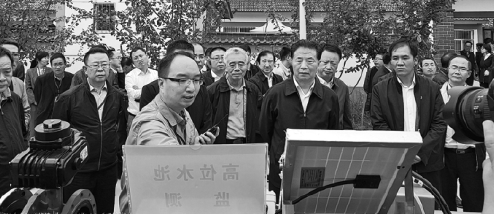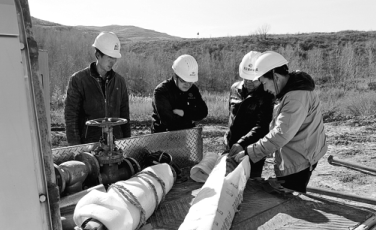Water quenches thirst for growth
Reliable supply transforms once barren area into a hive of productivity and profit





With the help of automation and smart technology, residents of one of China's driest areas are getting affordable clean water instead of yearning for rainfall.
It took people living in the central and south of Ningxia Hui autonomous region nearly 40 years to complete this arduous journey.
"In the past, we had to pour the water into the jar and let it settle before drinking it," says Li Xiaoqin, a villager at Chengyang village of Pengyang county in the southeast of the autonomous region.
Zhang Shixiang, Party secretary of the village, says they used to carry water two kilometers to home, and it took two hours just to get the water.
"We didn't have drinking water, let alone water to shower," Li says, adding that they now have tap water not only to drink and shower, but also to clean the house, water the flowers, feed livestock, and importantly, flush the toilet.
Today, the nearly 200,000 people living in the countryside of Pengyang, can, through phone access, check water quality and pay fees. Crucially, water charges are the same as those for townsfolk.
The southern mountainous area of the autonomous region, including where the county is located, is often referred to as Xihaigu.
Forty years ago, it was a dry and rainless place where barren hills stretched on and on and ravines and gullies crisscrossed. Groundwater was scarce.
Water resource per capita was less than one-sixth of the average amount nationwide, according to Jiang Qi, a member of the National Committee of the Chinese People's Political Consultative Conference and director of the institute for desertification control at the Ningxia Academy of Agricultural and Forestry Sciences.
Scarcity of water had once been a constraint for the region's high-quality development, he says.
A regional government document on poverty alleviation released in September 2016 shows that rain-fed farming accounted for 90 percent of total farmlands in underdeveloped areas of the autonomous region, and 80 percent of the cultivated land yielded not much and unsteadily.
Yet, annual rainfall of the county ranges from 350 to 550 millimeters, around one-third of the amount of evaporation, and rainfall from July through September takes up more than 60 percent of the whole year, making the situation in other seasons even worse, according to a government introduction of Pengyang's natural geographic features.
However, with a stable water source now, the locals are actively planting red plum apricots (a local specialty), pepper, edible mushrooms and Chinese medical herbs, and also raising chickens, bees, cattle and sheep.
Niu Detan, general manager of the county's water supply management company, says some locals who used to work outside have come back to run breeding businesses, or operate greenhouses and plant orchards.
People's income is growing every year, Niu says.
All this is thanks to a water transfer project that makes it possible for more than one million people of the Xihaigu area to access safe drinking water since 2016.
The project transfers water from the Jinghe River by the east foot of the Liupan Mountain in southern Ningxia. The river is a tributary of the Weihe River, which, itself, is a tributary of the Yellow River.
Based on the project, the county government of Pengyang invested further to integrate updated internet technology especially to improve the quality and stability of water supply in rural areas.
Zhang admitted that facilities didn't work well at first and water quality was not satisfying.
The county later transformed the facilities in the reservoir, the pump station and the pipe network, and equipped every household with smart water meters, which enables real-time video monitoring of the whole water supply process, as well as remote control and management on computer and phone.
The water management staff can monitor the PH value and turbidity of the water online. Once there's a breakdown, the system would automatically sound the alarm and distribute maintenance tasks.
According to Niu, if there were a communication failure at the pump station, the system inside the station would be able to supply water steadily for at least a week.
The intelligent facilities have solved the problem of high cost and management difficulty caused by rural households being numerous but scattered, Jiang says.
Therefore, water fees are lowered in these underdeveloped villages where pipelines have to go through mountains and ditches.
As Ningxia has already built a unified online platform before to manage water conservancy information, and facilities to provide internet access for rural areas, the county doesn't have to invest much on internet infrastructure for the transformation such as server and the machine room, nor the data operation and security issues, according to Niu.
Over the past decade, Ningxia has been prioritizing the resolution to provide rural areas with safe drinking water. Tap water penetration has risen from 26 percent at the end of 2006 to 90 percent by 2019.
"We have historically solved the problem of water shortage and covered the barren hills with green," says Ma Hancheng, vice-chairman of the autonomous region and a deputy to the National People's Congress at a recent interview with chinanews.com.
Ningxia is now seeking to promote the intelligent water supply facilities of Pengyang to the whole region and is determined to provide replicable and referential experience for the country, where freshwater resource is much limited and distributes unevenly.
The region is calling for more financial and policy support from the country, according to a recent proposal from the region's water conservancy department.





Today's Top News
- Agreement boosts ocean governance
- Experts: Punishments law misinterpreted
- Project weaves global map of silk's grand history
- Cross-border research work bearing fruit
- Disrupting market under fabricated veneer of 'national security' hurts US' own interest: China Daily editorial
- Yasukuni visit would add insult to injury: China Daily editorial


























